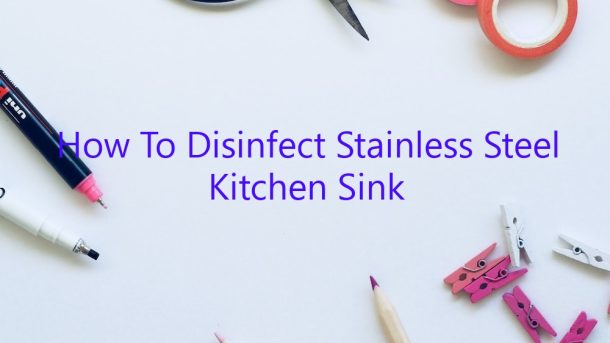Stainless steel kitchen sinks are a popular choice in many homes because of their modern look and easy to clean surface. While they are easy to clean, they can also be a breeding ground for bacteria if not disinfected on a regular basis.
Here are a few tips on how to disinfect your stainless steel kitchen sink:
1. Start by mixing together one gallon of warm water with one tablespoon of bleach.
2. Pour the mixture into the sink and let it soak for a few minutes.
3. Use a scrub brush to scrub the sink clean.
4. Rinse the sink with clean water and dry it with a towel.
5. Repeat this process on a regular basis to keep your sink bacteria-free.
Contents
How do I sanitize my kitchen sink?
A kitchen sink is one of the most heavily used areas in a home. It is important to keep it clean and sanitized to prevent the spread of germs and illness. Here are a few steps to sanitize your kitchen sink.
1. Start by filling the sink with hot water and adding a few drops of dish soap.
2. Scrub the sink with a brush to remove any dirt or grime.
3. Rinse the sink with hot water.
4. Add a sanitizing solution to the hot water and rinse the sink again.
5. Let the sink air dry or dry it with a towel.
Sanitizing your kitchen sink is a quick and easy way to keep it clean and free of germs.
What Disinfectant can be used on stainless steel?
Stainless steel is a popular choice for kitchen appliances and countertops because it is durable and easy to clean. However, it can be susceptible to bacteria and other contaminants if not properly disinfected. There are a number of different disinfectants that can be used on stainless steel, but some are more effective than others.
One of the most common disinfectants for stainless steel is bleach. Bleach is a powerful disinfectant that can kill a wide variety of bacteria and viruses. However, it can also be corrosive, and it can damage the finish on stainless steel appliances and countertops.
Another common disinfectant for stainless steel is vinegar. Vinegar is a natural disinfectant that is safe to use on stainless steel. It is not as effective as bleach, but it is less corrosive and it is less likely to damage the finish on appliances and countertops.
There are also a number of commercial disinfectants that can be used on stainless steel. These disinfectants are typically more effective than vinegar or bleach, but they can also be more expensive.
When choosing a disinfectant for stainless steel, it is important to consider the safety and efficacy of the product. Bleach is a powerful disinfectant, but it can be hazardous if not used properly. Vinegar is safe to use, but it is not as effective as bleach. Commercial disinfectants are typically more effective than vinegar or bleach, but they can be more expensive.
How do I disinfect my kitchen sink without bleach?
The kitchen sink is one of the most commonly used areas in the home, and it can often become dirty and bacteria-laden. While many people think that bleach is the best way to disinfect a sink, there are actually several other methods that are just as effective – and sometimes safer – than bleach.
One way to disinfect a kitchen sink without bleach is to use vinegar. Vinegar is a natural disinfectant and can kill most types of bacteria. To disinfect a sink with vinegar, pour a gallon of vinegar into the sink and let it sit for 30 minutes. Then, rinse the vinegar out of the sink with hot water.
Another way to disinfect a kitchen sink without bleach is to use baking soda. Baking soda is a natural abrasive and can help to remove bacteria and dirt from the sink. To disinfect a sink with baking soda, pour a cup of baking soda into the sink and scrub the surface with a damp sponge.
Finally, another way to disinfect a kitchen sink without bleach is to use hydrogen peroxide. Hydrogen peroxide is a natural disinfectant and can kill most types of bacteria. To disinfect a sink with hydrogen peroxide, pour a cup of hydrogen peroxide into the sink and let it sit for 10 minutes. Then, rinse the hydrogen peroxide out of the sink with hot water.
Will vinegar ruin stainless steel sink?
It is a question that has been asked by many a homeowner with a stainless steel sink – will vinegar ruin stainless steel? The answer, as it turns out, is a bit more complicated than a simple yes or no.
Vinegar is a weak acid and, as such, can corrode stainless steel over time. The rate of corrosion will depend on a number of factors, including the concentration of vinegar, the age and condition of the stainless steel, and the type of vinegar.
White vinegar is the most corrosive, while apple cider vinegar is the least. Acetic acid, the main component of vinegar, is what causes the corrosion. If you are concerned about your stainless steel sink, it is best to avoid using vinegar altogether.
If you do choose to use vinegar, be sure to rinse the sink thoroughly afterwards to remove any traces of the acid. You can also apply a coat of wax or polish to the sink to help protect it from corrosion.
What is the best way to clean a stainless steel sink?
Stainless steel is a durable and easy-to-clean material, but it can still become dirty over time. If your stainless steel sink is not clean, it can be difficult to keep your kitchen looking its best. Fortunately, there are several ways to clean a stainless steel sink.
One way to clean a stainless steel sink is to use a vinegar and water solution. Vinegar is a natural cleaning agent and it can help remove dirt, bacteria, and grease from your sink. To create a vinegar and water solution, mix one part vinegar with three parts water. Soak a cloth in the solution and then use it to wipe down your sink.
Another way to clean a stainless steel sink is to use baking soda. Baking soda is a natural abrasive and it can help remove dirt and grease from your sink. To clean your sink with baking soda, sprinkle a small amount of baking soda onto a damp cloth. Rub the baking soda into the surface of your sink and then rinse it off with water.
If your sink is really dirty, you may need to use a more powerful cleaner. In this case, you can use a commercial stainless steel cleaner. These cleaners are available at most hardware stores and they are specifically designed to clean stainless steel appliances and fixtures.
No matter what method you use to clean your stainless steel sink, be sure to rinse it thoroughly with water afterwards. This will help remove any cleaning solutions and it will also help prevent streaks and water spots.
Can Lysol wipes be used on stainless steel?
Lysol wipes are a popular choice for cleaning many surfaces in the home, but can they be used on stainless steel? The answer is yes, with a few caveats.
First, it’s important to make sure that the Lysol wipes are labelled as safe to use on stainless steel. Many Lysol wipes are safe to use on a variety of surfaces, but some are specifically designed for use on stainless steel.
Second, it’s important to make sure that the stainless steel is not damaged. If the surface is scratched, dented, or corroded, the Lysol wipes may not be able to clean it effectively.
Third, it’s important to test the Lysol wipe on a small, inconspicuous area of the stainless steel to make sure that it does not cause any damage.
If all of these conditions are met, then Lysol wipes can be safely used to clean stainless steel. They are a great choice for quickly and easily removing fingerprints, smudges, and dirt from the surface.
Can you use Lysol disinfectant on stainless steel?
Lysol is a disinfectant that is widely available and can be used to clean a variety of surfaces. However, there is some confusion about whether or not it is safe to use Lysol on stainless steel.
Lysol contains ammonia and bleach, both of which can corrode stainless steel. In addition, Lysol can leave a film on stainless steel that can be difficult to remove. For these reasons, it is generally not recommended to use Lysol on stainless steel.
There are, however, some exceptions. If you are careful to avoid getting Lysol on the surface of the stainless steel, and you remove any film that is left behind, it may be safe to use Lysol in some cases. always check the manufacturer’s instructions before using any disinfectant on stainless steel.




